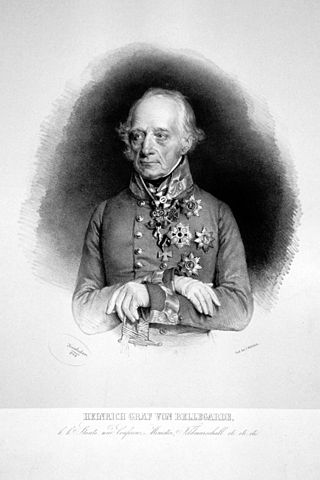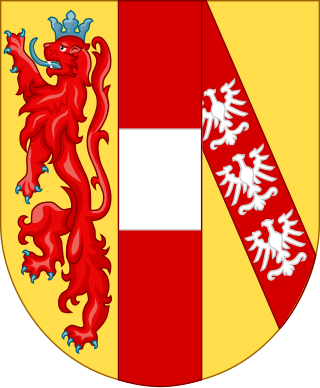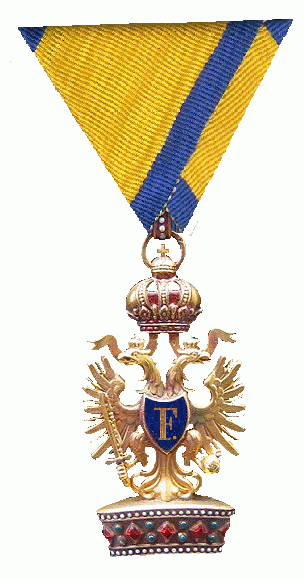History
Permanent councils of war had already been summoned by the Habsburg emperor Maximilian I about 1500. The council was initially called a regiment, and later a secret body, state government, court council or state council. In 1529 it was considered necessary to establish an independent war council but the negotiations remained unsuccessful for a long time. On February 25, 1531, Ferdinand I issued an instruction in Linz, which ordered the compilation of an independent war council consisting of four war councilors.
Founded on 17 November 1556 during the reign of Emperor Ferdinand I, the Steter Kriegsrat (Permanent War Council) was a council of five generals and senior civil servants. It oversaw the entire Habsburg military system in war and peace and decided on fortress construction, army equipment, salary issues and the purchase of supplies, as well as the planning and implementation of wars. It also handled civil and military administration of the border region of Croatia. [1] On 31 December 1556, all military authorities were ordered to submit to the War Council. The title Hofkriegsrat was first used in 1564. The Hofkriegsrat submitted to the Imperial Chamber as a financial authority and to the Imperial Chancellery as a point of political coordination.
With the establishment of a standing Imperial Army in the 17th century, the Hofkriegsrat was the bureaucracy charged with managing the permanent military force. It served as the central military administrative agency and a military chancery, provided a staff for the emperor, and directed and coordinated field armies. Additionally, it conducted relations with the Ottoman Empire and administered the Military Frontier (Militärgrenze).
All generals had to apply for authorisation for any strategic decisions, except for the generalissimo , a rule that ensured coordinated action but proved disadvantageous facing an aggressive opponent like the Prussian king Frederick the Great. Emperor Joseph II further centralized the body and gave it supreme authority over all branches of the military administration. When the reforming Archduke Charles was appointed president of the Hofkriegsrat by Emperor Francis II in 1801, he divided the agency into three departments, dealing with military, judicial, and administrative matters.
Following the Napoleonic Wars, the Hofkriegsrat, as one of four components of the governing State Council (Staatsrat), continued to exert control over the military to the will of the Emperor of Austria. Its bureaucracy was cumbersome and decisions were often arrived at only after much argument and circulation of papers. While the presidents were always officers, section heads were frequently civilians and there was often tension between them. The military men resented interference by what Radetzky would later call a civilian "despotism". An additional problem was presented in the fact that in a time when the general staff was growing in importance in other countries (notably Prussia), in Austria it remained only a subordinate section of the Hofkriegsrat.
Amidst the growing nationalist troubles leading up to the 1848 Revolutions, the Hofkriegsrat investigated the reliability of units with suspect loyalties. In 1833 it ruled that all soldiers in the imperial army belonging to Mazzini's Italian nationalist Young Italy movement were guilty of high treason and were to be court-martialed. In the 1840s it investigated even the traditionally loyal South Slav Grenzer but determined that they would likely act as ordered, especially if in action against the Hungarians.
With effect from 1 June 1848 the Hofkriegsrat was turned into the Austrian Ministry of War. According to the Austro-Hungarian Compromise of 1867, it became one of the three common ministries of the dual monarchy.

The chancellor of Austria, officially the federal chancellor the Republic of Austria, is the head of government of the Republic of Austria.

Count Heinrich von Bellegarde, Viceroy of Lombardy-Venetia, of a noble Savoyard family, was born in Saxony, joined the Saxon army and later entered Habsburg military service, where he became a general officer serving in the Habsburg border wars, the French Revolutionary Wars and the Napoleonic Wars. He became a Generalfeldmarschall and statesman.

The Battle of Caldiero took place on 30 October 1805, pitting the French Armée d'Italie under Marshal André Masséna against an Austrian army under the command of Archduke Charles, Duke of Teschen. The French engaged only some of their forces, around 33,000 men, but Archduke Charles engaged the bulk of his army, 49,000 men, leaving out Paul Davidovich's corps to defend the lower Adige and Franz Seraph of Orsini-Rosenberg's corps to cover the Austrian right against any flanking maneuvers. The fighting took place at Caldiero, 15 kilometres east of Verona, during the War of the Third Coalition, part of the Napoleonic Wars.

Baron Paul Kray of Krajova and Topolya, was a soldier, and general in Habsburg service during the Seven Years' War, the War of Bavarian Succession, the Austro–Turkish War (1787–1791), and the French Revolutionary Wars. He was born in Késmárk, Upper Hungary.

Freiherr Joseph Alvinczi von Borberek a.k.a. Baron József Alvinczi de Borberek was a soldier in the Habsburg Army and a field marshal of the Austrian Empire. He is remembered for handing Napoleon his first two defeats, at the battles of Bassano and Caldiero, both in 1796 and just days apart. Napoleon would later remark that Alvinczi was the best general he had fought thus far.

The Military Order of Maria Theresa was the highest military honour of the Habsburg monarchy, Austrian Empire and Austro-Hungarian Empire.

The House of Habsburg-Lorraine originated from the marriage in 1736 of Francis III, Duke of Lorraine and Bar, and Maria Theresa of Austria, later successively Queen of Bohemia, Queen of Hungary, Queen of Croatia and Archduchess of Austria. Its members form the legitimate surviving line of both the House of Habsburg and the House of Lorraine, and they inherited their patrimonial possessions from the female line of the House of Habsburg and from the male line of the House of Lorraine.

The Order of Saint Stephen is an order of chivalry founded in 1764 by Maria Theresa. In 1938, Miklós Horthy took the rights and activities of Grand Master as Regent of Hungary. The name of the Order changed to the Royal Hungarian Order of Saint Stephen. The Order was terminated at the time of the proclamation of the Second Hungarian Republic in 1946. It was recreated in 2011 as the Hungarian Order of Saint Stephen, and to this day remains the highest order in Hungary.

The Battle of Würzburg was fought on 3 September 1796 between an army of the Habsburg monarchy led by Archduke Charles, Duke of Teschen and an army of the First French Republic led by Jean-Baptiste Jourdan. The French attacked the archduke's forces, but they were resisted until the arrival of reinforcements decided the engagement in favor of the Austrians. The French retreated west toward the Rhine River. The action occurred during the War of the First Coalition, part of the French Revolutionary Wars. Würzburg is 95 kilometres (59 mi) southeast of Frankfurt.

Baron Josef Philipp Vukassovich was a Croatian soldier who joined the army of Habsburg monarchy and fought against both Ottoman Empire and the First French Republic. During the French Revolutionary Wars, he commanded a brigade in the 1796–1797 Italian campaign against Napoleon Bonaparte. He led a division during the Napoleonic Wars and received a fatal wound in action.

Friedrich Freiherr (Baron) von Hotze, was a Swiss-born general in the Austrian army during the French Revolutionary Wars. He campaigned in the Rhineland during the War of the First Coalition and in Switzerland in the War of the Second Coalition, notably at Battle of Winterthur in late May 1799, and the First Battle of Zurich in early June 1799. He was killed at the Battle of Linth River.

Heinrich XV, Prince Reuss of Greiz was the fourth of six sons born into the reigning family of the Principality of Reuss. At the age of fifteen he joined the army of the Habsburg monarchy and later fought against Ottoman Turkey. During the French Revolutionary Wars he became a general officer and saw extensive service. He commanded a corps during the Napoleonic Wars. From 1801 until his death, he was Proprietor (Inhaber) of an Austrian infantry regiment.

Maximilian, Count von Merveldt, among the most famous of an illustrious old Westphalian family, entered Habsburg military service, rose to the rank of General of Cavalry, served as Francis II, Holy Roman Emperor's ambassador to Russia, and became special envoy extraordinaire to the Court of St. James's. He fought with distinction in the wars between the Habsburg and the Ottoman empires, the French Revolutionary Wars, and the Napoleonic Wars.

Count Ignác Gyulay de Marosnémeti et Nádaska, Ignácz Gyulay, Ignaz Gyulai was a Hungarian military officer, joined the army of the Habsburg monarchy, fought against Ottoman Turkey, and became a general officer during the French Revolutionary Wars. From 1806 he held the title of Ban of Croatia. In the struggle against the First French Empire during Napoleonic Wars, he commanded army corps. At the time of his death, he presided over the Hofkriegsrat, the Austrian Council of War.

The Battle of Verona was fought on 18 October 1805 between the French Army of Italy under the command of André Masséna and an Austrian army led by Archduke Charles, Duke of Teschen. By the end of the day, Massena seized a bridgehead on the east bank of the Adige River, driving back the defending troops under Josef Philipp Vukassovich. The action took place near the city of Verona in northern Italy during the War of the Third Coalition, part of the Napoleonic Wars.

Franz Freiherr von Werneck, enlisted in the army of Habsburg Austria and fought in the Austro-Turkish War, the French Revolutionary Wars, and the Napoleonic Wars. He had a distinguished career until 1797, when he was dismissed for losing a battle, and reinstated in 1805. In that year he surrendered his command and was later brought up on charges. He died while awaiting a court-martial.

The Imperial Order of the Iron Crown was one of the highest orders of merit in the Austrian Empire and Austria-Hungary until 1918. It was founded in 1815 by Emperor Franz I of Austria as a re-establishment of the original Order of the Iron Crown, which previously had been an order of the Napoleonic Kingdom of Italy.

General of the Cavalry was a rank in the Imperial Army of the Holy Roman Empire, Imperial Army of the Austrian Empire and the Army of Austria-Hungary.
Heinrich Franz von Mansfeld, Prince of Fondi was an Austrian diplomat, Field marshal and President of the Hofkriegsrat.

















